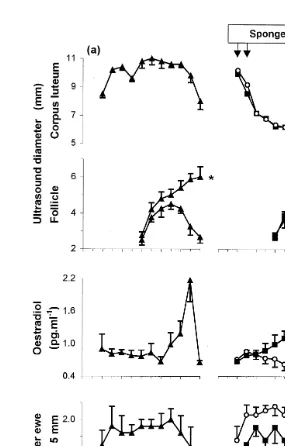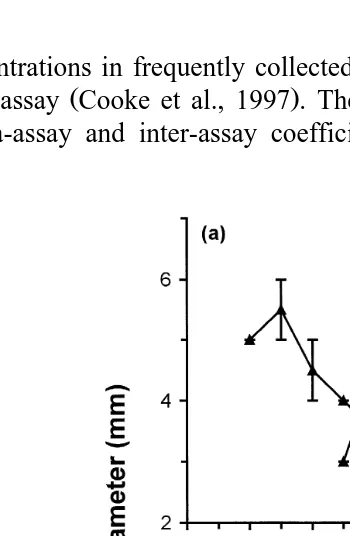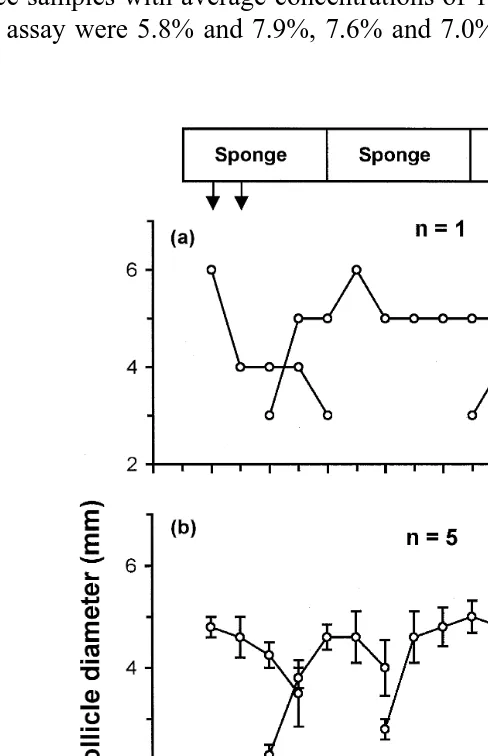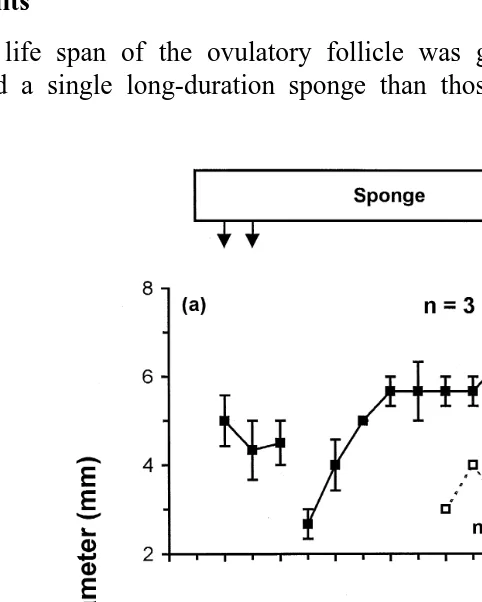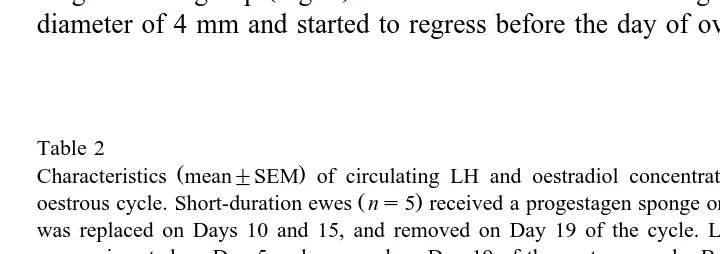www.elsevier.comrlocateranireprosci
Progestagen synchronisation in the absence of a
corpus luteum results in the ovulation of a persistent
follicle in cyclic ewe lambs
J.D. Flynn
a, P. Duffy
b, M.P. Boland
a, A.C.O. Evans
a,)a
Department of Animal Science and Production, Faculty of Agriculture, Conway Institute for Biomolecular and Biomedical Research, UniÕersity College Dublin, Belfield, Dublin 4, Ireland
b
Lyons Research Farm, UniÕersity College Dublin, Newcastle, Co. Dublin, Ireland Received 17 December 1999; received in revised form 6 March 2000; accepted 6 March 2000
Abstract
Progestagens are widely used to synchronise oestrous in sheep but the effects on follicular dynamics are not clear. We tested the hypothesis that when luteolysis occurs early during progestagen synchronisation prolonged growth of the ovulatory follicle will occur. Cyclic ewe
Ž . Ž .
lambs 40.0"0.3 kg were divided into three groups: eight ewes Long group received a
Ž .
progestagen sponge 60 mg medroxyprogesterone acetate from Days 5 to 19 after oestrous and
Ž .
eight ewes Short group received a progestagen sponge on Day 5 which was replaced on Day 10 and again on Day 15, and removed on Day 19 after oestrous. On Days 6 and 7, ewes in both
Ž .
groups received prostaglandin. A third group ns5, Control did not receive any treatment. The
growth and development of follicles G2 mm in diameter were characterised using daily
transrectal ultrasonography. On Day 18, blood samples were collected every 12 min for 8 h from five ewes in the Long and Short groups. Data were analysed by ANOVA. The maximum diameter
Ž . Ž .
and age emergence to ovulation of the ovulatory follicle was greater P-0.01 in ewes in the
Ž . Ž
Long group 7.4"0.2 mm and 12.1"0.6 days than in ewes in the Short group 6.3"0.2 mm
. Ž .
and 5.1"0.5 days and Control group 6.3"0.4 mm and 6.8"0.6 days . On Day 18 of the
Ž .
cycle, LH pulse frequency and oestradiol concentrations were greater P-0.05 in ewes in the
Ž y1. Ž
Long group 3.2"1.1 pulse per 8 h and 1.15"0.09 pg ml than the Short group 0.8"0.4
y1.
pulses per 8 h and 0.54"0.08 pg ml .
We suggest that the negative feedback efficacy of a long-term progestagen sponge decreased with time and led to an increase in LH pulse frequency and prolonged growth of the ovulatory
)Corresponding author. Tel.:q353-1-706-7771; fax:q353-1-706-1103.
Ž .
E-mail address: [email protected] A.C.O. Evans .
0378-4320r00r$ - see front matterq2000 Elsevier Science B.V. All rights reserved. Ž .
follicle. We conclude that, in the absence of luteal progesterone, synchronisation with a single progestagen sponge for 14 days resulted in higher LH pulse frequency and ovulation of a
persistent follicle with a larger maximum diameter, compared with controls. q2000 Elsevier
Science B.V. All rights reserved.
Keywords: Synchronisation; Ovulation; Follicles; LH; Sheep-ovary
1. Introduction
In cattle, the model of waves of follicular growth and the existence of a dominant
Ž .
follicle is widely accepted Fortune, 1994; Ginther et al., 1996; Roche et al., 1998 . The existence of a similar pattern of follicular growth in sheep has been controversial;
Ž
however, it now appears that waves of follicular growth occur in sheep Noel et al.,
.
1993; Ginther et al., 1995; Evans et al., 2000 .
Progesterone and progestagens are used widely to synchronise oestrous in cattle and sheep. The effect of these treatments on follicular growth in cattle is well documented, but this is not the case with sheep. In cattle, if plasma progesterone concentrations are
Ž y1.
maintained at subluteal concentrations 1 to 2 ng ml prolonged growth of the
Ž .
ovulatory follicle occurs Sirois and Fortune, 1990; Savio et al., 1993 . These concentra-tions of progesterone are created when cattle without an active corpus luteum are treated with an intravaginal device for long periods as the progesterone-releasing ability of the
Ž .
intravaginal device decreases Sirois and Fortune, 1990 . This intermediate plasma
Ž
progesterone concentration results in a higher LH pulse frequency Roberson et al.,
.
1989; Stock and Fortune, 1993; Kinder et al., 1996 and the development of larger ovulatory follicles than those observed in cattle with luteal concentrations of
proges-Ž .
terone Sirois and Fortune, 1990; Savio et al., 1993; Bigelow and Fortune, 1998 . The efficacy of prostagen treatments to synchronise oestrus in sheep has been
Ž .
documented Gordon, 1997 but the effects on the growth of the ovulatory follicle are unclear. Synchronisation of oestrus with progesterone or prostagens results in a concep-tion rate of 70% to 80%. It is possible that the reason why some of the 20% to 30% of ewes that fail to conceive may be because these animals ovulate a poor-quality oocyte from a prolonged follicle. This may happen in ewes when natural luteolysis occurs early in the synchronisation treatment leaving the intravaginal device as the only source of negative feedback on gonadotrophin secretion. If the efficacy of the sponge decreases with time it may lead to a situation where subluteal plasma concentrations of proges-terone exist leading to an increase in the LH pulse frequency and hence prolonged
Ž .
growth of ovulatory follicles as described in cattle Mihm et al., 1999 .
When progesterone concentrations in ewes were maintained at less than 1 ng mly1, using customised implants or injections of oil, the diameter and the age of the ovulatory follicle was increased compared to ewes with progesterone concentrations of greater
y1 Ž .
than 1 ng ml Johnson et al., 1996 . While progesterone is used in some
synchronisa-Ž
tion protocols in sheep, many products use more potent synthetic progestagens
Robin-.
son et al., 1967 . The initial release of progestagen from intravaginal sponges is high but
Ž .
treatments at different stages of the oestrous cycle on follicle growth have been
Ž .
examined in ewes Leyva et al., 1998 . The results were equivocal due to the lack of continuous data on the growth of ovulatory follicles and the asynchronous decrease in endogenous progesterone concentrations. Hence, the efficacy of progestagen synchroni-sation on the negative feedback regulation of LH secretion and the resultant effect on follicle growth towards the end of the treatment remains to be established.
The aim of the present experiment was to synchronise oestrus using different progestagen treatments in ewe lambs in which luteolysis was induced early in the synchronisation period and to examine the effect on LH concentrations and the growth of the ovulatory follicle. We tested the hypothesis that in the absence of luteal progesterone, ewes synchronised for 14 days with a single long-duration progestagen sponge will ovulate an older follicle and have higher LH pulse frequency than ewes
Ž
synchronised for 14 days with three short-duration sponges removed and replaced every
.
5 days .
2. Materials and methods
2.1. Animals and treatments
Ž .
During November, 10 Suffolk and 11 Texel cross ewe lambs 40.0"0.3 kg were
Ž .
maintained at pasture 53818’N where they had ad libitum access to water. A raddled, vasectomised ram was kept with the ewes to detect oestrus. The ewes were each fed 0.4
Ž .
kg of concentrates 19% crude protein per day.
The ewes were presynchronised with an intravaginal sponge containing 60 mg
Ž .
medroxyprogesterone actate Veramix sponge, Upjohn . On Day 5 of the subsequent oestrous cycle ewes were assigned to one of three groups. Eight ewes received a new sponge on Day 5 of the cycle that was left in place for 14 days and was removed on Day
Ž .
19 Long group . A second group of 8 ewes received a new sponge on Day 5 of the cycle; the sponge was replaced with a new sponge on Days 10 and 15 and removed on
Ž .
Day 19 Short group . Ewes in both the Long and the Short groups received
prosta-Ž w .
glandin 0.5 ml i.m. Prosolvin ; Intervet, Cambridge, UK on Days 6 and 7 of the
Ž
oestrous cycle. Finally, a group of five ewes did not receive any treatment Control
. Ž .
ovulation . All procedures including ultrasonography and blood sampling were li-censed by the Department of Health and Children, Ireland, in accordance with the cruelty to animals act, 1876 and European Community Directive 86r609rEC.
2.2. Transrectal ultrasonography
Follicular growth patterns were studied daily from Day 6 of the oestrous cycle by
Ž
transrectal ultrasonography using a real time B mode scanner Dynamic Imaging
.
Ž .
cattle. The transducer was wrapped in a polythene tube 40 cm long, 15 mm o.d. so that it was rigid and thus could be inserted into the rectum and manipulated externally. The ewes were restrained in a darkened room in a fostering crate on a raised platform. A lubricant gel was used as a coupling medium between the rectal wall and the transducer. Images of the urinary bladder and the uterine horns were used in locating the position of the ovaries. The position and diameter of corpora lutea and follicles G2 mm were
Ž .
recorded on a diagram each day Evans et al., 2000 .
2.3. Characteristics of follicular deÕelopment
An identified follicle was defined as a follicle that grew to at least 4 mm in diameter and was at least 3 mm in diameter for three or more days. Follicles with growth characteristics not meeting these criteria were defined as unidentified follicles. The day of emergence was retrospectively traced as the day that follicles were first recorded with a diameter of 2 or 3 mm. A follicle first identified at 4 mm was assumed to have been 3 mm in diameter the day before. The day that the largest follicle disappeared and was later replaced by a corpus luteum was termed the day of ovulation. The interval between the day of emergence of the ovulatory follicle and the day of ovulation was referred to as the life span of the ovulatory follicle.
The growth profile of identified follicles was tabulated and the number of waves of follicular growth produced by each animal was observed. Data from ewes with a similar number of follicular growth waves that were in the same treatment group were amalgamated for presentation in graph form. This was done by plotting the aligned growth profiles of the largest follicles in each wave to the mean day of emergence.
2.4. Blood collection and hormone analysis
Ž .
Blood samples 7 ml were collected daily from Days 6 to 19 of the oestrous cycle by
Ž .
jugular venepuncture or until oestrus in control animals . The samples were stored at
Table 1
Ž . Ž
Mean "SEM oestrous cycle lengths and the characteristics of the ovulatory follicle in the control not
. Ž
treated , short-duration a progestogen sponge was inserted on Day 5 of the oestrous cycle, replaced on Days
. Ž
10 and 15, and removed on Day 19; prostaglandin was given on Days 6 and 7 and long-duration sponge
.
inserted on Day 5 and removed on Day 19 of the cycle; prostaglandin was given on Days 6 and 7 treatment groups
Ž .
Values in rows with no common superscript are different ab: P-0.05; cd: P-0.01 .
Characteristic Control Short-duration Long-duration
Žns5. Žns8. Žns8.
d c c
Ž .
Cycle length days 15.8"0.3 22.0"0.3 21.5"0.3 Ovulatory follicle
Emergence day of cycle 10.0"0.7 17.5"0.7 10.4"0.8
b b a
Ž .
Maximum diameter mm 6.3"0.4 6.3"0.2 7.4"0.2
a a a
Ž .
Ž . Ž).
Fig. 1. Mean "SEM diameter of the corpus luteum, ovulatory follicle and largest subordinate follicle of
Ž . Ž .
the ovulatory wave, oestradiol concentration and numbers of medium 4 and 5 mm and large G6 mm
Ž . Ž . Ž
follicles in control a; triangles; no treatment; ns5 and sponge treated ewes b . Short-duration ewes circles;
.
ns8 received a progestagen sponge on Day 5 of the oestrous cycle that was replaced on Days 10 and 15, and
Ž .
removed on Day 19 of the cycle. Long-duration ewes squares; ns8 had a sponge inserted on Day 5 and
Ž .
removed on Day 19 of the oestrous cycle. Both short- and long-duration ewes received prostaglandin arrows
Ž .
48C for 24 h and were then centrifuged at 1500=g for 20 min at a temperature of 48C. The serum was decanted and stored at y208C until assayed for oestradiol concentra-tions.
On Day 18 of the cycle five ewes were selected at random from each of the
Long-Ž .
and Short-duration groups and blood samples 5 ml were taken every 12 min for 8 h. These blood samples were stored and processed in a similar manner to the daily blood samples. The pulsatile pattern of LH in circulation was analysed using the PC Pulsar
Ž .
pulse detection algorithm Gitzen and Ramirez, University of Illinois . The G
parame-Ž . Ž .
ters G –G1 5 used were 4.4, 2.6, 1.92, 1.46 and 1.13 Merriam and Wachter, 1982 . The pattern of LH secretion is described in terms of mean and basal concentration, pulse frequency and pulse amplitude.
2.5. Radioimmunoassays
LH concentrations in frequently collected serum samples were assayed by validated
Ž . y1
radioimmunoassay Cooke et al., 1997 . The sensitivity of the assay was 0.1 ng ml and the intra-assay and inter-assay coefficients variation for reference samples with
Ž .
Fig. 2. The mean "SEM daily diameter of the largest follicle in each wave of follicular growth observed in
Ž . Ž). Ž .
the control group ns5, not treated . Two ewes ovulated a follicle from the second wave a , and three
Ž .
average concentrations of 0.41 ng mly1, 1.68 ng mly1 and 3.52 ng mly1 included in each assay were 1.9% and 10.9%, 2.7% and 7.4%, 5.4% and 5.9%, respectively.
Oestradiol concentrations in serum samples collected each day were assayed by
Ž .
validated radioimmunoassay Prendiville et al., 1995 . The sensitivity of the assay was 0.2 pg per ml of serum. The intra-assay and inter-assay coefficients of variation for reference samples with average concentrations of 1.78, 2.76 and 5.37 pg mly1 included
in each assay were 5.8% and 7.9%, 7.6% and 7.0%, 6.6% and 9.9%, respectively.
Ž .
Fig. 3. The mean "SEM daily diameter of the largest follicle in each wave of follicular growth observed in
Ž
the short-duration treatment group ns8, 60 mg medroxyprogesterone acetate sponge inserted on Day 5 of
. Ž .
the oestrous cycle, replaced on Days 10 and 15, and removed on Day 19, boxes . Prostaglandin arrows was
Ž). Ž .
given on Days 6 and 7. One ewe ovulated a follicle from the third wave a , five ewes ovulated a follicle
Ž . Ž .
2.6. Statistics
Data were analysed using ANOVA or the general linear models procedure and
Ž .
included day, treatment, ewe and interactions where necessary SAS, Cary, NC .
Ž .
Multiple comparisons were made by the method of Tukey P-0.05 . Prior to analyses, data were subject to Hartley’s test for heterogeniety of variance and logarithmic transformations were done where necessary to yield homogeniety of variance. All values given are the mean"SEM.
3. Results
Ž .
The life span of the ovulatory follicle was greater P-0.01 in the ewes that received a single long-duration sponge than those that received three short-duration
Ž .
Fig. 4. The mean "SEM daily diameter of the largest follicle in each wave of follicular growth observed in
Ž
the long-duration treatment group ns8, 60 mg medroxyprogesterone acetate sponge inserted on Day 5 of the
. Ž .
oestrous cycle, and removed on Day 19 treatment group. Prostaglandin arrows was given on Days 6 and 7.
Ž). Ž .
Three ewes ovulated a follicle from the second wave a and five ewes ovulated a follicle from the third
Ž .
wave b of follicle growth. A total of three ewes developed identified follicles while the prolonged follicle
Ž .
Ž .
sponges and control ewes Table 1 . The day of emergence of the ovulatory follicle was
Ž .
similar P)0.05 between ewes in the control and long-duration groups, but was later
ŽP-0.01 in ewes in the short-duration group Table 1 . The maximum diameter of the. Ž .
Ž .
ovulatory follicle in ewes in the long-duration group was greater P-0.01 than that in
Ž .
ewes in the short-duration and control groups Table 1 . All of the 21 ewes ovulated a single follicle. Based on once-a-day heat checking with raddled rams, the time from
Ž .
sponge withdrawal to oestrus was not different P)0.05 between groups of ewes that
Ž . Ž .
were treated with a single 2.3"0.4 days or multiple 3.0"0.5 days sponges.
Ž .
The diameter of corpora lutea decreased P-0.01 after prostaglandin injection in sponge-treated ewes and were no longer ultrasonically visible after Day 13.7"0.6 of
Ž .
the cycle Fig. 1 . On Day 15 and between Days 17 and 19 there were more large
Ž .
follicles present G6 mm in diameter, P-0.05 and between Days 15 and 18 plasma
Ž .
concentrations of oestradiol were greater P-0.05 in long-duration ewes than
short-Ž . Ž .
duration ewes Fig. 1 . On Days 18 to 20 there were fewer P-0.05 medium-sized
Ž .
follicles 4 and 5 mm in diameter present in the long-duration ewes than short-duration
Ž . Ž .
ewes Fig. 1 . There was no difference P)0.90 between groups for the numbers of
Ž
small follicles 2 and 3 mm in diameter, overall mean 2.8"0.3 follicle per ewe per
.
day .
During oestrous cycles, there were two or three waves of follicular growth in ewes in
Ž .
the control and long-duration groups Figs. 2 and 4 , and three, four or five waves of
Ž .
follicular growth in ewes in the short-duration group Fig. 3 . The ovulatory follicle developed in the last follicular wave in all cases. An identified follicle grew and regressed while the prolonged follicle was present in three of the eight ewes in the
Ž .
long-duration group Fig. 4 . In each case the follicle emerged and grew to a maximum
Ž .
diameter of 4 mm and started to regress before the day of ovulation Fig. 4 .
Table 2
Ž .
Characteristics mean"SEM of circulating LH and oestradiol concentrations in ewes on Day 18 of the
Ž .
oestrous cycle. Short-duration ewes ns5 received a progestagen sponge on Day 5 of the oestrous cycle that
Ž .
was replaced on Days 10 and 15, and removed on Day 19 of the cycle. Long-duration ewes ns5 had a sponge inserted on Day 5 and removed on Day 19 of the oestrous cycle. Both groups received prostaglandin on Days 6 and 7 of the cycle. Blood samples were collected every 12 min for 8 h for the pattern of LH in
Ž .
circulation and oestradiol concentrations are based on a single the first sample
Short-duration Long-duration Significance
Pulse amplitude 1.25"0.36 0.95"0.24 0.50
y1
Žng ml .
Pulse frequency 0.8"0.4 3.2"1.1 0.03
Žpulses per 8 h.
Mean oestradiol 0.54"0.08 1.15"0.09 0.01
y1
On Day 18 of the cycle, LH pulse frequency and mean oestradiol concentrations were
Ž . Ž .
greater P-0.03 in the long-duration than the short-duration ewes Table 2 . There
Ž . Ž .
was also a tendency for mean P-0.09 and basal P-0.10 LH concentrations to be
Ž .
greater in ewes in the long-duration than the short-duration group Table 2 .
4. Discussion
In the absence of a corpus luteum, synchronisation with a single progestagen sponge
Ž .
resulted in the ovulation of a prolonged dominant follicle Table 1, Fig. 1 . In contrast, when multiple sponges were used follicular waves emerged at more frequent intervals
Ž .
and a follicle of much shorter duration ovulated Table 1 . In support of the presence of a prolonged dominant follicle, ewes treated with a single long-duration sponge had higher serum concentrations of oestradiol late in the prostagen treatment period than ewes treated with three short-duration sponges.
Ž .
The regression of the corpus luteum in both the single long-duration and multiple
Ž . Ž .
sponge short-duration treatment groups Fig. 1 confirmed that these animals were under the influence of exogenous progestagens alone. Towards the end of the 14-day synchronisation period, LH pulse frequency was greater in ewes that had a single sponge
Ž .
compared with ewes that received multiple sponges Table 2 , suggesting that the sponge was less efficient as a negative feedback regulator of LH secretion with longer-term use. Serum medroxyprogesterone acetate concentrations have been shown to
Ž .
decrease by 63% between Days 2 and 13 of use Greyling et al., 1994 demonstrating that the progestagen supply decreases with time. An inverse relationship between LH
Ž
pulse frequency and progesterone concentrations is well documented in sheep Goodman
.
and Karsh, 1980 . In cattle, an association between intermediate progesterone concentra-tions, increased LH pulse frequency and the development of prolonged dominant
Ž .
follicles has been described Stock and Fortune, 1993; Mihm et al., 1999 . In sheep,
Ž
experimentally created low progesterone concentrations lead to larger follicles Vinoles
. Ž
et al., 1999 , older ovulatory follicles and higher oestradiol concentrations Johnson et
.
al., 1996 .
Ewes bred after synchronisation with progestagens have conception rates of 70% to
Ž .
80% Gordon, 1997 . In any flock where synchronisation starts at random stages of the oestrous cycle, a portion of the ewes will be in the late luteal phase and will therefore be primarily under then influence of exogenous progestagens towards the end of the synchronisation period. We have shown that this situation will lead to the ovulation of prolonged follicles in ewe lambs. We speculate that ewes that ovulate a prolonged dominant follicle will be less fertile than those ovulating short-duration follicles. This
Ž
relationship between duration of dominance and fertility has been shown in cattle Mihm
. Ž . Ž
et al., 1994 . The reason for this may Binelli et al., 1999 or may not Wehrman et al.,
.
1997 involve an effect on the uterine environment for early embryo development but it is likely that it involves a prematurely activated, and therefore a poor quality, oocyte
ŽRevah and Butler, 1996; Mihm et al., 1999 . In sheep, when progesterone in corn oil.
was injected subcutaneously conception rates were lower in ewes with low progesterone
Ž y1. Ž y1. Ž
.
al., 1996 . This decrease was thought to be due to a reduction in fertilisation rates or early embryo survival; however, these ewes ovulated multiple follicles but only one
Ž .
follicle in eight of nine ewes had a longer than normal life span Johnson et al., 1996 . Future studies are needed to examine the contribution of prolonged dominant follicles to fertility in sheep.
Between Days 16 and 20 of the cycle there were fewer medium-sized follicles in ewes synchronised with a single long-duration sponge than ewes synchronised with
Ž .
multiple sponges Fig. 1 . This suggests that prolonged dominant follicles inhibited the growth of other follicles within the ovaries and supports the concept of dominance in
Ž .
sheep Rubianes et al., 1997; Evans et al., 2000 . However, this dominance effect was
Ž
only partial. There was no difference between groups for the number of small follicles 2
.
and 3 mm on any day of the cycle, and in three of the eight ewes identified follicles grew to 4 mm and regressed while the large prolonged dominant follicle was present
ŽFig. 4 . Nonetheless, these follicles never appeared to challenge the largest follicle to.
replace it as the ovulatory follicle. In other studies in sheep, new follicles developed
Ž
while a prolonged follicle was present and in some cases ovulated Johnson et al., 1996;
.
Leyva et al., 1998 . Hence, the dominance of the large maintained follicle over other follicles is questionable.
In conclusion, in the absence of luteal progesterone ewe lambs synchronised with a single progestagen sponge for 14 days had higher LH pulse frequency and ovulated older follicles of larger maximum diameter than ewe lambs synchronised with progesta-gen sponges that were replaced every 5 days over a 14-day period. The fertility of ewes ovulating prolonged dominant follicles remains to be established.
Acknowledgements
We thank N. Hynes and G. Claffey for doing the radioimmunoassays; B Enright, J Fox, V Gath, E Lane, J Lozano, D Nation, P Quinn, F Ward and C Wright for help with
Ž .
blood collection; Clonatech, France Argene Biosoft for the progesterone antibody and NIDDK and A.F. Parlow for reagents for the LH assay.
References
Bigelow, K.L., Fortune, J.E., 1998. Characteristics of prolonged dominant versus control follicles: follicle cell numbers, steroidogenic capabilities, and messenger ribonucleic acid for steroidogenic enzymes. Biol. Reprod. 58, 1241–1249.
Binelli, M., Hampton, J., Buhi, W.C., Thatcher, W.W., 1999. Persistent dominant follicle alters pattern of oviductal secretory proteins from cows at estrus. Biol. Reprod. 61, 127–134.
Cooke, D.J., Crowe, M.A., Roche, J.F., 1997. Circulating FSH isoform patterns during recurrent increases in FSH throughout the oestrous cycle of heifers. J. Reprod. Fertil. 110, 339–345.
Evans, A.C.O., Duffy, P., Hynes, N., Boland, M.P., 2000. Waves of follicle development during the estrous cycle in sheep. Theriogenology 53, 699–715.
Fortune, J.E., 1994. Ovarian follicular growth and development in mammals. Biol. Reprod. 50, 225–232. Ginther, O.J., Kot, K., Wiltbank, M.C., 1995. Associations between emergence of follicular waves and
Ginther, O.J., Wiltbank, M.C., Fricke, P.M., Gibbons, J.R., Kot, K., 1996. Selection of the dominant follicle in cattle. Biol. Reprod. 55, 1187–1194.
Goodman, R.L., Karsh, F.J., 1980. Pulsatile secretion of luteinizing hormone: differential suppression by ovarian steroids. Endocrinology 107, 1286–1290.
Gordon, I., 1997. Controlled Reproduction in Sheep and Goats. CAB International, New York.
Greyling, J.P.C., Kotze, W.F., Taylor, G.J., Hagendijk, W.J., Cloete, F., 1994. Synchronization of oestrous in sheep: use of different doses of progestagen outside the normal breeding season. S. Afr. J. Anim. Sci. 24, 33–37.
Johnson, S.K., Dailey, R.A., Inskeep, E.K., Lewis, P.E., 1996. Effect of peripheral concentrations of progesterone on follicular growth and fertility in ewes. Domest. Anim. Endocrinol. 13, 69–79.
Kinder, J.E., Kojima, F.N., Bergfeld, E.G., Wehrman, M.E., Fike, K.E., 1996. Progestin and estrogen regulation of pulsatile LH release and development of persistent ovarian follicles in cattle. J. Anim. Sci. 74, 1424–1440.
Leyva, V., Buckrell, B.C., Walton, J.S., 1998. Regulation of follicular activity and ovulation in ewes by exogenous progesterone. Theriogenology 50, 395–416.
Merriam, G.R., Wachter, K.W., 1982. Algorithms for the study of episodic hormone secretion. Am. J. Physiol. 243, E310–E318.
Mihm, M., Baguisi, A., Boland, M.P., Roche, J.F., 1994. Association between the duration of dominance of the ovulatory follicle and pregnancy rate in beef heifers. J. Reprod. Fertil. 102, 123–130.
Mihm, M., Curran, N., Hyttle, P., Knight, P.G., Boland, M.P., Roche, J.F., 1999. Effect of dominant follicle persistence on follicular fluid oestradiol and inhibin and on oocyte maturation in heifers. J. Reprod. Fertil. 116, 293–304.
Noel, B., Bister, J.L., Paquay, R., 1993. Ovarian follicular dynamics in Suffolk ewes at different periods of the year. J. Reprod. Fertil. 99, 695–700.
Prendiville, D.J., Enright, W.J., Crowe, M.A., Finnerty, M., Hynes, N., Roche, J.F., 1995. Immunization of heifers against gonadotropin-releasing hormone: antibody titers, ovarian function, body growth, and carcass characteristics. J. Anim. Sci. 73, 2382–2389.
Revah, I., Butler, W.R., 1996. Prolonged dominance of follicles and reduced viability of bovine oocytes. J. Reprod. Fertil. 106, 39–47.
Roberson, M.S., Wolfe, M.W., Stumpf, T.T., Kittok, R.J., Kinder, J.E., 1989. Luteinizing hormone secretion and corpus luteum function in cows receiving two levels of progesterone. Biol. Reprod. 41, 997–1003. Robinson, T.J., Moore, N.W., Holts, P.J., Smith, J.F., 1967. The evaluation of several progestagens
administered in intravaginal sponges for the synchronization of oestrous in the entire cyclic Merino ewe.
Ž .
In: Robinson, T.J. Ed. , The Control of the Ovarian Cycle in Sheep. Sydney University Press, Sydney, pp. 76–101.
Roche, J.F., Mihm, M., Diskin, M.G., Ireland, J.J., 1998. A review of regulation of follicle growth in cattle. J.
Ž .
Anim. Sci. 76 Suppl. 3 , 16–29.
Rubianes, E., Ungerfeld, R., Vinoles, C., Rivero, A., Adams, G.P., 1997. Ovarian response to gonadotropin treatment initiated relative to wave emergence in ultrasonographically monitered ewes. Theriogenology 47, 1479–1488.
Savio, J.D., Thatcher, W.W., Morris, G.R., Entwistle, K., Drost, M., Mattiacci, M.R., 1993. Effects of induction of low plasma progesterone concentrations with a progesterone-releasing intravaginal device on follicular turnover and fertility in cattle. J. Reprod. Fertil. 98, 77–84.
Sirois, J., Fortune, J.E., 1990. Lengthening the bovine estrous cycle with low levels of exogenous progesterone a model for studying ovarian follicular dominance. Endocrinology 127, 916–925.
Stock, A.E., Fortune, J.E., 1993. Ovarian follicular dominance in cattle: relationship between prolonged growth of the ovulatory follicle and endocrine parameters. Endocrinology 132, 1108–1114.
Vinoles, C., Meikle, A., Forsberg, M., Rubianes, E., 1999. The effect of subluteal levels of exogenous progesterone on follicular dynamics and endocrine patterns during the early luteal phase of the ewe. Theriogenology 51, 1351–1361.

